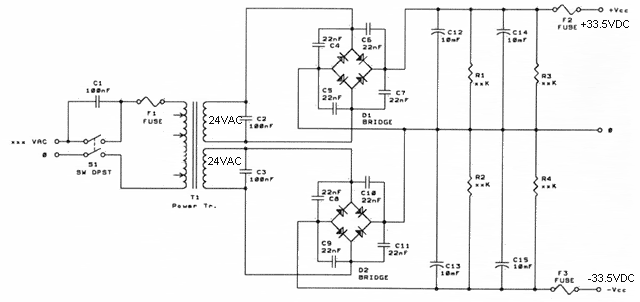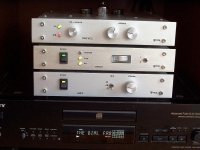A = Anode
B = Grid
C = Cathode
High voltage supplies could probably just as well be +-50V or so, which you may be able to get using a voltage doubler from the existing transformer that powers the LM3875 (John Broskie at Tubecad had a nice article on that). For lower HV rails, you might want to look at lowering the 10k resistor to perhaps 8.2k.
B = Grid
C = Cathode
High voltage supplies could probably just as well be +-50V or so, which you may be able to get using a voltage doubler from the existing transformer that powers the LM3875 (John Broskie at Tubecad had a nice article on that). For lower HV rails, you might want to look at lowering the 10k resistor to perhaps 8.2k.
Originally posted by SY FWIW, the only RSD tubes I have are ECC81 and they are also just terrible. Only the GE JAN and 6201 measured worse...
I have a number of different RSD tubes, but not all are bad. For instance, I have several RSD EF184 for spares for a tube scope I have and they all seem perfectly fine - they even look to be made with different style parts inside, would not surprise me if they were built by a completely different factory. I also have a few PL36 and PL504 by RSD along with some other assorted ones but I have not measured these. To be honest I don't expect them to be very good 🙁
On the otehr hand I have a few PCC88s by Valvo that are over 35 years old and worked for who knows how long in TV tuners, and except for the gm being on the lowish side of normal, the mu is spot on and the sections are matched to within 10%. In other words, if they are used, it does not necessairly follow they are junk - but neither does NOS mean they are good!
Franz seemed pretty set on the 60V....
Also getting trannies here tends to be a mission, so I have them custom made elsewere.... So I just need to figure out how many amps the 60V secondary should be able to handle...
Also getting trannies here tends to be a mission, so I have them custom made elsewere.... So I just need to figure out how many amps the 60V secondary should be able to handle...
Franz seemed pretty set on the 60V....
No! Not at all!
It was a restriction* for the small design of the very small VBITNGC. And it sounds very good 😀
But: not the voltage per se is important, it is the current.
Franz
*to be exactly: +60V/-60V, so 120V (a lethal voltage). The restriction is caused by the size of the bypass caps, available just for 63V in this size.
Still shoping around for tubes...
What is the diffirence betweem 6922EH and 6922 they both have E88CC as equivalent no... ?
What is the diffirence betweem 6922EH and 6922 they both have E88CC as equivalent no... ?
Nordic said:Still shoping around for tubes...
What is the diffirence betweem 6922EH and 6922 they both have E88CC as equivalent no... ?
6922EH = 6922 by Electro Harmonix (IIRC this is new production but I don't remember which one of the east Europeans is making it)
Valve buffer gainclone - voltage doubler
OK trying to save a few bucks I started reading up a bit about voltage doublers, and I think I at least get the basic principles..
My Power supply for the GC looks as follows:

I got this basic outline of a voltage doubler looking as follows
Now the question is this... please don't laugh.
Can I connect a voltage doubler to the above PSU , or would it need its own trafo..?
OK trying to save a few bucks I started reading up a bit about voltage doublers, and I think I at least get the basic principles..
My Power supply for the GC looks as follows:

I got this basic outline of a voltage doubler looking as follows
An externally hosted image should be here but it was not working when we last tested it.
Now the question is this... please don't laugh.
Can I connect a voltage doubler to the above PSU , or would it need its own trafo..?
The simple answer is: No, you cannot connect the voltage doubler you have shown in your post to the power supply in your post. BUT, you can ADD a voltage doubler to the power supply in your post, it would look somewhat different than what you have drawn - some extra diodes and capacitors. It would also need regulators for the HV rails, this should not be a problem.
I suggest that if you are going to be playing with tubes, you should read the back-issues of the tube cad journal, by John Broskie, www.tubecad.com, he has one complete issue devoted to voltage doublers and tripplers, and how to get higher rail voltages from existing lower voltage power supplies. Surely you don't expect us to do all your work for you? 🙂
I suggest that if you are going to be playing with tubes, you should read the back-issues of the tube cad journal, by John Broskie, www.tubecad.com, he has one complete issue devoted to voltage doublers and tripplers, and how to get higher rail voltages from existing lower voltage power supplies. Surely you don't expect us to do all your work for you? 🙂
I went scratching in the garage and found 4 valves, one is a ECC83, this any good? I ask cause going to earlier posts this must be a stereo valve... also got a ECL82, but only one, and I think those are mono...
Hey guys, I can report that I build the circuit I posted.
ECC88 with 10k and 3k3 resistor.
My PSU delivers + and -71V, so I take it the 10k resistor leaves us at 14mA. Pretty hard to believe it can sound much better, but I'll take your word for it, and will at the very least try most modifications you come up with.
I'm currently bidding on 2 Sowters input transformers (3603 600/600 1:1CT ), would these be suitable to use infront of the buffer?, would the volume control go infront or after these?
ECC88 with 10k and 3k3 resistor.
My PSU delivers + and -71V, so I take it the 10k resistor leaves us at 14mA. Pretty hard to believe it can sound much better, but I'll take your word for it, and will at the very least try most modifications you come up with.
I'm currently bidding on 2 Sowters input transformers (3603 600/600 1:1CT ), would these be suitable to use infront of the buffer?, would the volume control go infront or after these?
- Status
- Not open for further replies.
- Home
- Amplifiers
- Tubes / Valves
- valve buffer gainclone
